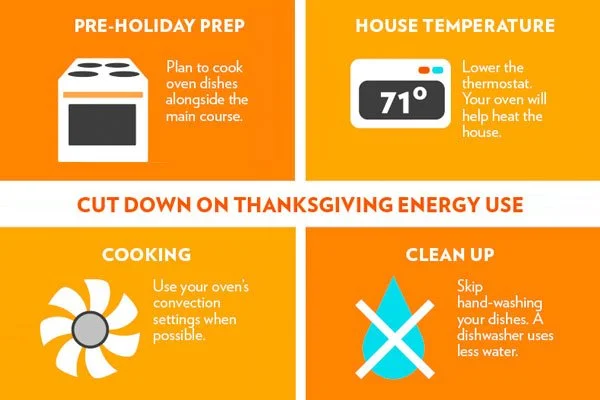10 ENERGY-SAVING TIPS TO GOBBLE UP THIS THANKSGIVING
With help from Performance Point, you can ensure your electric bill will look as good as your Thanksgiving dinner.
If a big group of people is expected for dinner, lower the thermostat a couple degrees before the guests arrive. The oven will keep the house warm, not to mention people generate heat as well!
Check the refrigerator/freezer doors to make sure they are sealed tightly. This will keep the cold air in and the warm air out. To test, close the refrigerator door on a dollar bill. If you can slip the bill out easily or if it falls out on its own, the door requires adjustment, or the gasket needs replacing.
Allow hot foods and liquids to cool before putting them in the refrigerator. Uncovered, hot food and liquids release vapors that make the refrigerator work harder. Use a lid or plastic wrap to cover the food and place in the refrigerator after cooling.
Use a “lids-on” approach to cooking. Tightly fitted lids on pots and pans help keep heat in, enabling you to lower the temperature settings and lessen the cooking times.
When boiling liquids, start by using the highest temperature settings to reach the boiling point. Then lower the heat control setting and allow the food to simmer until fully cooked.
Use ceramic or glass pans — you can turn down the oven’s temp by up to 25 degrees and get the same results. That’s because these materials retain heat so well, they’ll continue cooking food even after being removed from the oven.
When preheating your regular oven, time the preheat period carefully. Five to eight minutes should be enough time. There is no need to preheat for broiling or roasting.
When using an electric oven, cook as much of your meal as possible in it at one time. Foods with different cooking temperatures can often be cooked simultaneously at one temperature – variations of 25 degrees Fahrenheit in either direction still produce good results and save energy.
When all the cooking is done, don’t use your oven’s self-cleaning cycle unless a major cleaning job is needed. Wipe up minor spills and splatters with a damp cloth. When you do use the oven’s self-cleaning feature, start the cycle right after cooking, while the oven is still hot, or wait until late evening hours when use of electricity is lowest.
Finally, use your dishwasher. It saves energy and water, so only hand-wash things that aren’t dishwasher-safe. Wait until you’ve got a full load before starting the dishwasher. Be sure to stop the appliance before the heated dry cycle; just open the door and let your dishes air-dry.

